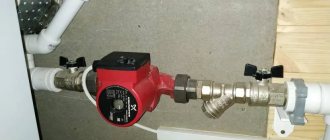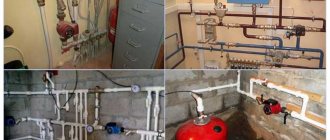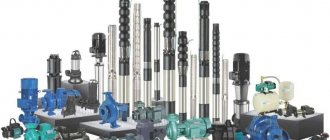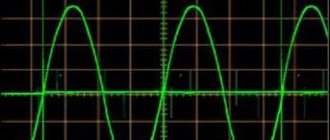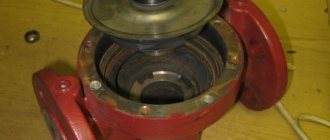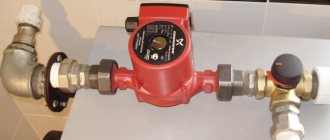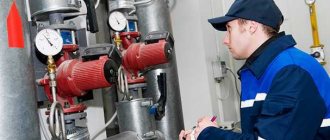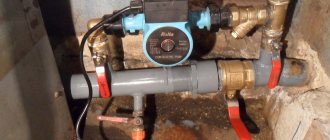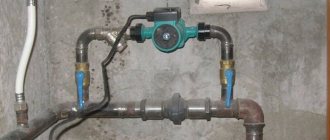Most autonomous heating systems that are used to heat country houses and cottages are today equipped with circulation pumps. In order to achieve the required results when installing such a hydraulic machine, it is necessary to perform a preliminary calculation of the circulation pump for the heating system and, based on the obtained values, select pumping equipment with the appropriate characteristics.
Proper selection of a circulation pump will ensure efficient operation of the heating system and avoid unnecessary costs
Types of circulation pumps
The design of a typical circulation pump consists of a housing made of stainless metal, a ceramic rotor and a shaft equipped with a wheel with blades. The rotor is driven by an electric motor. This design ensures that water is taken from one side of the device and pumped into pipelines from the outlet side. The movement of water through the system occurs due to centrifugal force. In this way, the resistance that arises in individual sections of the heating pipes is overcome.
All such devices are divided into two types - dry and wet. In the first case, there is no contact of the rotor with the pumped water. Its entire working surface is separated from the electric motor by special protective rings, carefully polished and adjusted to each other. The operation of dry-type pumps is considered more efficient, but during operation there is quite a lot of noise. In this regard, separate isolated rooms are equipped for their installation.
When choosing such models, you should take into account the presence of air turbulence generated during operation. Under their influence, dust rises into the air, which can easily get inside the device and break the tightness of the sealing rings. This will lead to failure of the entire system. Therefore, a thin film of water is present between the rings as protection. It provides lubrication, preventing premature wear of the rings.
Wet-type circulation pumps have a distinctive feature in the form of a rotor that is constantly located in the pumped liquid. The location of the electric motor is securely separated by a sealed metal cup. These devices are usually used in small heating systems. They make much less noise during operation and do not require additional maintenance measures. Typically, such pumps are periodically repaired and adjusted to the required parameters.
A significant disadvantage of these pumps is considered to be the low efficiency due to the insufficient tightness of the sleeve separating the stator and the coolant
When choosing the right model, you should pay attention to the fact that the pump has not only a wet rotor, but also a protected stator
The latest generations of circulation pumps are almost completely automated. Smart automation ensures timely switching of winding levels and significantly increases the productivity of the device. Such models are most often used when water flow is stable or slightly varying. Thanks to stepwise adjustment, it is possible to select the most optimal operating modes and significant energy savings.
How to buy a quality pump, not a fake
Having considered the questions of how to choose a heating pump for a heating system, we will give recommendations on how to distinguish a counterfeit unit from a genuine one.
No matter how the sellers of counterfeit devices assure you that their product is in no way inferior to the original products of well-known pumping equipment manufacturing companies, do not believe them. You will save on buying the circulation pump itself, but you will create a lot of problems. For example, the warranty period for servicing counterfeit equipment is about six months. While a manufacturer that has won a name in the international market guarantees at least 5 years of trouble-free operation. Therefore, when purchasing, pay attention to:
- Quality of paintwork. You will not be able to find any defects on the original products.
- Indication of the country in which the specific unit was manufactured.
- Match the product number and model on the packaging, in the technical data sheet and the pump itself.
- Availability of complete operating instructions and warranty booklet.
We hope that thanks to our recommendations, you will not only be able to select a circulation heating pump for your autonomous heating system in a private home, but also purchase a high-quality mechanism.
We calculate the power of the heating pump
When selecting a suitable heating pump, you need to take into account the operating point from which the unit starts operating and at which it will be installed. This position is characterized by two indicators: flow and pressure.
Calculation of heating boiler power. Click to enlarge.
The first is measured in cubic meters per hour, and the second in meters. These indicators depend on the operating characteristics of the pump in the system and its characteristics.
When calculating a specific pump intended for heating, they strive to select an option in which the starting point is equal to the power of the unit itself and the power consumption of the heating system.
This pattern can be traced only on a special graph. Using this procedure, you can calculate whether the pump is powerful enough for this consumption system.
In order to find out the power consumption of the heating pump, you should use a special formula. It looks like this:
P2(kW) = (p * Q * H) / 367 * efficiency.
The p-value represents the density level of the water that is being pumped. Q characterizes the flow level, and H – accordingly, the pressure level.
Pump performance level
If you are seriously interested in how to calculate a heating pump, then you will need a formula designed to calculate the heat performance level of a potential pump. It looks like this:
Q = S * Qsp / 1000.
It follows from it that S demonstrates the area that is heated, and Qsp shows the level of specific thermal energy consumption. This indicator is slightly different for apartment buildings and private buildings. For the former, the specific heat consumption is 70 watts per square meter, while for private houses it is 100 watts.
Feed rate
To calculate the degree of fluid supply, you will need the formula:
V = Q / (1.16 * T), in which V is the actual supply level, the value of 1.16 is considered the stable heat capacity of water, and T is a certain temperature difference (for an average room this is somewhere from ten to twenty degrees ).
Pressure level
The pump pressure is calculated using the formula:
H = R * L * ZF / 10000.
In it, the degree of resistance of the existing pipeline and heating system is presented as R, the longest section of the system is marked with the letter L, and ZF means the safety factor. By the way, for a traditional heating scheme this coefficient is 2.2, and for hot water supply systems it increases by 0.4.
Calculation of system hydraulic resistance
A calculation based on the power of the boiler may not be enough, because the system differs from system to system in length, pipe diameter, the presence of turns, the number of radiators and fittings - and these are all obstacles in the flow path.
Knowing the hydraulic resistance is important in order to determine the required pressure. Pressure is an indicator of the height to which a given pump can theoretically raise a column of water
Reflects the pump's ability to overcome system resistance
Pressure is an indicator of the height to which a given pump can theoretically raise a column of water. Reflects the pump's ability to overcome system resistance.
It is possible to calculate the exact pressure at home only if you have access to technical literature. The exact calculation formula is:
H = (R * L + Z) : p * V
- H is the required value (pressure).
- R – resistance of the straight section (100 – 150 – obtained experimentally).
- L – total length of pipes.
- Z – tabular data. Resistance of each fitting and fixture.
- P – coolant density.
- V – coolant movement speed.
And for approximate calculations you will only need to measure the total length of the pipes and estimate the amount of fittings.
For every 10 m of pipes you will need 0.6 m of pump pressure (supply and return are measured, rounded to the nearest ten and the resulting figure is multiplied by 0.6).
20–70% is added to the result (the minimum figure for simple systems, the maximum for those overloaded with reinforcement).
For reference:
- A three-way mixer takes up 20% of the speed;
- Fitting – 30%;
- Thermal relay – 70%.
Purpose and types
As already mentioned, the main task of the circulation pump is to provide the required speed of coolant movement through the pipes. For systems with forced circulation, only under such conditions will the design capacity be achieved. During operation of the circulation system, the pressure in the system increases slightly, but this is not its task. It's more of a side effect. To increase the pressure in the system there are special booster pumps.
Wet rotor circulation water pumps are more popular
There are two types of circulation pumps: dry and wet rotor. They differ in design, but perform the same tasks. To choose what type of circulation pump you want to install, you need to know their advantages and disadvantages.
With dry rotor
It got its name due to its design features. Only the impeller is immersed in the coolant; the rotor is in a sealed housing, separated from the liquid by several sealing rings.
The design of a circulation pump with a dry rotor - only the impeller is in the water
These devices have the following properties:
- They have high efficiency - about 80%. And this is their main advantage.
- Requires regular maintenance. During operation, solid particles contained in the coolant fall on the sealing rings, breaking the tightness. Maintenance is required to prevent depressurization.
- Service life is about 3 years.
- During operation they produce a high level of noise.
This set of characteristics is not very suitable for installation in heating systems of private houses. Their main advantage is high efficiency, which means lower energy consumption. Therefore, in large networks, circulation pumps with a dry rotor are more economical, and are mainly used there.
With wet rotor
As the name implies, in equipment of this type, both the impeller and the rotor are located in the liquid. The electrical part, including the starter, is enclosed in a sealed metal cup.
Wet rotor pump design - only the electrical part is dry
This type of equipment has the following properties:
- Efficiency is about 50%. Not the best indicator, but for small private heating systems this is not critical.
- No maintenance required.
- Service life is 5-10 years depending on the brand, operating mode and condition of the coolant.
- During operation they are almost inaudible.
Based on the above properties, choosing a circulation pump by type is not difficult: most people choose devices with a wet rotor, since they are more suitable for working in an apartment or private house.
Example as a check
It was previously determined that the building's heat requirement is 45.6 kW, and the coolant flow required for heating is 2.02 cubic meters per hour. The piping diagram to the most distant radiator includes four sections and a heat control valve.
The total pressure losses in them are equal to:
DP = 0.63 + 0.111 + 0.142 + 0.289 = 1.178 m
According to SNiP 2.04.05-91*, 10% should be added to this value for unaccounted pressure losses:
DP = 1.178 x 1.1 = 1.296 m
When calculating using the method outlined in the article, we obtain:
H = 0.015 x (3.2 + 4.4 + 8.9 + 21.7) x 1.3 x 1.7 = 1.266 m,
which is not too different from the value obtained earlier.
Water heating with a special pump required for pumping the coolant is in many ways superior to similar systems with natural circulation of the working environment. The efficiency with the installation of such a device increases significantly. In addition, additional possibilities arise in terms of adjustment. As for the pipelines used, you can choose products with a smaller diameter, and this allows you to create very economical heating networks.
A forced circulation heating system will work properly provided that the performance and some other parameters of the pump are correctly selected. First of all, you should clarify how much coolant the product can pump in a specific period of time.
Initially, it is not advisable to purchase a pump model with a large supply of performance characteristics. Firstly, the cost of the device will be too high, so you will have to spend a significant part of the budget. Secondly, the device will consume excess energy, since as power increases, its consumption also increases.
Last but not least, when choosing, you should take into account the factors of comfort and quality characteristics. For a quiet stay, it is, of course, better to purchase a device that does not create a lot of noise and is durable. These requirements are usually met by products from trusted manufacturers that have been on the market for a long time.
Selection of pump by pressure and flow
The next stage of calculating the circulation pump is more complex and consists of determining its operating pressure. It should be enough to overcome:
- resistance to friction of water against pipeline walls;
- local resistances that change the flow structure (turns, tees, fittings, equipment, and so on).
In mathematical terms, the formula for calculating the pump power, that is, the required pressure, is as follows:
P = Rl + Z, where:
P – total pressure loss in the system that must be overcome by the pump, Pa;
- R – specific friction losses, Pa/m;
- l – length of a pipeline of the same diameter, m;
- Z – pressure drop in local resistances, Pa.
This is where the jungle begins, which is sometimes very difficult for an ordinary homeowner to understand. We propose to calculate the pump pressure in a simpler way. To do this you need to follow the algorithm:
We take the value 1000i from the same column (ours is 139.9) and calculate the friction resistance of the entire pipe. If we take its length to be 20 m in the example given, then the resistance will be:
139.9 / 1000 x 20 = 2.8 m water column or 0.28 bar. Since the heating system consists of pipes of different diameters, it is necessary to calculate the resistance of each of them in the same way. After this, all the results are summed up and we obtain the total pressure loss due to friction (the Rl value in the formula).
To make the final selection of the pump according to its parameters, it remains to find out the amount of pressure loss in local resistances (Z value in the formula). As for the boiler, shut-off valves and radiators, their resistances are indicated in the technical data sheet; they must be summed up and added to the previous figure for friction losses. The pressure drop at turns, tees and other local resistances should simply be taken as 20% of the total friction losses and added to the previously obtained amount. This completes the calculation.
Basic Design Rules
Heated floor design
- The length of each 16 mm loop should not exceed 100 m (or 120 for pipes with a diameter of 20 mm). The shorter the length of the pipes, the more economical the system will be, since a weaker circular pump will be required.
- The optimal option for 16 mm pipes is considered to be a length of 65 m, or approximately 10 m2. The pump flow rate to operate in such a room (10 m2) must be at least 2 liters per minute.
- It is necessary to design the circuits in such a way that they have a uniform length and do not differ from each other by more than 10-20%, taking into account the supply to the collector.
- The optimal distance between pipes is 150 mm.
- The surface temperature should not exceed 30 degrees. In most cases this is enough. Keep in mind that the coolant temperature may be 10-20 degrees higher.
- The most optimal way to lay pipes is “snail”. This option distributes heat evenly over the surface and does not create large hydraulic losses due to smooth turns.
- Since it is colder on the floor next to the outer walls, the laying step there is 1.5 times smaller, but not less than 10 centimeters.
- Fastening the pipes is best done according to the markings. You can’t do without it especially if there are obstacles that need to be avoided or oblique corners.
An example of an ideal heated floor
Warm floor design
- The base has height differences of less than 3 cm;
- Insulation with a thickness of 3 centimeters is used, thereby increasing the efficiency of the system; it does not heat the floor in the downward direction. It is best to use polystyrene foam or polystyrene foam with a density higher than 35 kg/m3.
- The concrete screed has a thickness of 4-10 cm.
- Reinforcing mesh is used to reinforce the screed and distribute heat evenly.
- Pipes made of polyethylene or metal-plastic are used. There is not much difference between them, except in ease of installation: metal-plastic will be easy to install, since it simply bends.
- The larger the diameter of the pipes, the lower the flow resistance and heat transfer will be, and therefore the higher the efficiency. Therefore, pipes with a diameter of 16 and 20 mm are usually used.
- A concrete screed with fine crushed stone is used as a protective and heat-distributing layer on top of the pipes.
A few additional tips
Longevity is largely influenced by the materials from which the main parts are made. Preference should be given to pumps made of stainless steel, bronze and brass. Pay attention to what pressure in the system the device is designed for.
Although, as a rule, there are no difficulties with this (10 atm is a good indicator). It is better to install the pump where the temperature is minimal - before entering the boiler. It is important to install a filter at the entrance. It is advisable to position the pump so that it “sucks” water from the expander. This means that the order in the direction of water movement will be as follows: expansion tank, pump, boiler.
Conclusion
So, in order for the circulation pump to work for a long time and conscientiously, you need to calculate its two main parameters (pressure and productivity).
You should not strive to comprehend complex engineering mathematics.
At home, an approximate calculation will be enough. All resulting fractional numbers are rounded up.
Useful tips
When choosing a pump for a heating system, preference should be given to designs with a “wet” rotor, since they operate very quietly and withstand higher loads than hydraulic devices of other modifications.
In addition, pay attention to the material of the case - opt for products made of stainless steel, bronze or brass. Preference should also be given to models with bearings and shafts made of ceramics. The service life of such equipment exceeds 20 years.
When installing the device into the system, it is necessary to ensure that the impeller shaft is positioned horizontally, that is, parallel to the pipe. If a suspicious noise appears during operation of the pump, this does not indicate a malfunction or a manufacturing defect. Try bleeding the air remaining in the system after starting.
Number of circulation pump speeds
Pump speed is the ability of the device to change productivity.
It’s easy to find out about the presence of modes - the description will indicate not one power, but several (usually three). In the same way, rotation speed and productivity are indicated in three options. For example: 70/50/35 W (power), 2200/1900/1450 rpm (rotation speed), head 4/3/2 m.
There are models that automatically change operating speed (and therefore productivity) depending on the ambient temperature.
To change the mode, there is a special switch on the pump body. It is recommended to set manual models to maximum power mode and reduce it if necessary. In automatic devices, you just need to remove the regulator from the lock.
The presence of speed modes is not only for increasing comfort. This is also justified economically. A regime device can save up to 40% of energy compared to a conventional one.
Installation diagrams
Depending on the number of connection points and the length of the pipes, the method of connecting the circulation pump and pipe routing is selected:
- serial connection with one circuit;
- parallel connection with the collector.
In the first case, all water intake points are connected in series and in one circuit. This is beneficial if you can easily combine the bathrooms and kitchen with one water pipe without unnecessary material costs and a fairly short route. There is only one feature that concerns the pressure pump rather than the circulation pump. If several water intake points are open at the same time, the pressure in each of them will be divided equally. Alternatively, this can be solved by installing a gearbox on each tap and choosing a more powerful pump.
The simplest installation diagram for a recirculation pump
Parallel connection solves the problem with pressure and water distribution using a manifold group and compact placement of gearboxes. In this case, recirculation pumps must be installed in each individual circuit or one more efficient pump must be selected for all groups at once. Such wiring is necessary if there are several bathrooms in the house, spaced far from each other and from the kitchen, or when, with a serial connection, the total length of the route becomes too long.
Areas of use of circulation pumps
The main task of the circulation pump is to improve the circulation of coolant through the elements of the heating system. The problem of already cooled water entering heating radiators is well known to residents of the upper floors of apartment buildings. Such situations are associated with the fact that the coolant in such systems moves very slowly and has time to cool before it reaches parts of the heating circuit located at a considerable distance.
When operating autonomous heating systems in country houses, in which water circulates naturally, you may also encounter a problem when radiators installed at the farthest points of the circuit barely heat up. This is also a consequence of insufficient coolant pressure and its slow movement through the pipeline. The installation of circulation pumping equipment allows you to avoid such situations both in apartment buildings and in private houses. By forcibly creating the required pressure in the pipeline, such pumps provide high speed movement of heated water even to the most distant elements of the heating system.
The pump increases the efficiency of existing heating and allows you to improve the system by adding additional radiators or automation elements
Heating systems with natural circulation of liquid that transfers thermal energy are effective when they are used to heat small houses. However, if you equip such systems with a circulation pump, you can not only increase the efficiency of their use, but also save on heating by reducing the amount of energy consumed by the boiler.
In terms of its design, the circulation pump is a motor whose shaft transmits rotation to the rotor. A wheel with blades is installed on the rotor - an impeller. Rotating inside the working chamber of the pump, the impeller pushes the heated liquid entering it into the discharge line, forming a coolant flow with the required pressure. Modern models of circulation pumps can operate in several modes, creating different pressures of the coolant moving through them in heating systems. This option allows you to quickly warm up the house when cold weather sets in by running the pump at maximum power, and then, when a comfortable air temperature has formed throughout the building, switch the device to an economical operating mode.
Circulation pump device for heating
All circulation pumps used to equip heating systems are divided into two large categories: devices with a “wet” and “dry” rotor. In pumps of the first type, all rotor elements are constantly in the coolant environment, and in devices with a “dry” rotor, only a part of such elements are in contact with the pumped medium. Pumps with a “dry” rotor are distinguished by greater power and higher efficiency, but they make a lot of noise during operation, which cannot be said about devices with a “wet” rotor, which produce a minimal amount of noise.
Supply (performance) of pumping equipment
This is one of the main factors to consider when choosing a device. Supply – the amount of coolant pumped per unit of time (m3/hour). The higher the flow, the greater the volume of liquid that the pump can pump. This indicator reflects the volume of coolant that transfers heat from the boiler to the radiators. If the supply is low, the radiators will not heat well. If the performance is excessive, home heating costs will increase significantly.
The power of circulation pumping equipment for a heating system can be calculated using the following formula: Qpu=Qn/1.163xDt [m3/h]
In this case, Qpu is the supply of the unit at the design point (measured in m3/hour), Qn is the amount of heat consumed in the area that is heated (kW), Dt is the temperature difference recorded on the forward and return pipelines (for standard systems this is 10- 20°C), 1.163 – indicator of the specific heat capacity of water (if another coolant is used, the formula must be adjusted).
Why do you need to do the calculation?
A circulation pump installed in a heating system must effectively solve two main problems:
- create such a liquid pressure in the pipeline that will be able to overcome the hydraulic resistance in the elements of the heating system;
- ensure constant movement of the required amount of coolant through all elements of the heating system.
When performing this calculation, two main parameters are taken into account:
- the building's total heat energy requirement;
- the total hydraulic resistance of all elements of the created heating system.
Table 1. Thermal power for various rooms
After determining these parameters, you can already calculate the centrifugal pump and, based on the obtained values, select a circulation pump with the appropriate technical characteristics. A pump selected in this way will not only provide the required coolant pressure and its constant circulation, but also operate without excessive loads, which can cause rapid failure of the device.
Advantages of a separate pumping unit
The use of pressure equipment is justified from the point of view of saving fuel and increasing boiler efficiency, which is why many companies integrate pumping units into boilers. But installing the unit separately has its advantages: quick replacement without removing the boiler, the ability to control the process in case of emergency situations (for example, using a bypass). In addition, the pump can be installed in a system not provided for by the project at the initial stage.
Despite the apparent simplicity of the choice, the parameters of the pump must be technically justified, for which mathematical calculations are carried out taking into account the laws of heat engineering, the individual characteristics of the system, therefore the exact choice must be made by a specialist who takes into account all factors based not only on theoretical knowledge, but also on practical experience.
Recommendations for installing pumps
In order to ensure normal circulation of fluid in the heating system, you need to make the right choice of the place where the pump will be installed. A location in the water suction area should be identified where excess hydraulic pressure is always present.
Most often, the highest point of the pipeline is selected, from which the expansion tank rises to a height of approximately 80 cm. The use of this method is possible in a room with a high altitude. It is usually practiced to install an expansion tank in the attic, provided that it is insulated for the winter.
In the second case, the tube is transferred from the expansion tank and cuts into the return pipe instead of the supply pipe. The suction pipe of the pump is located near this place, so the most favorable conditions are created for forced circulation.
The third installation option is to insert the pump into the supply line, directly behind the point at which water flows from the expansion tank. The use of such a connection is possible if a particular model is resistant to high water temperatures.
Inclusion of recirculation pumps in the gap between the network heater and the boiler.
In peak water heating boiler houses located in close proximity to heat consumers, when using fuel oil as fuel, for an open-loop heat supply circuit, a scheme was used to include recirculation pumps in the cut between the network heater and the boiler, Figure 5:
The recirculation pump supplies water to the boiler with a temperature of at least 110ºС, from where hot water with a temperature of 150ºС or more is supplied to the fuel oil system, to the make-up water heater and to the network heater. Cold water from the fuel oil facility is supplied to the return water pipeline, passes through the network heater and enters the network for heat consumers. Water from the network heater with a tP of at least 110ºC is supplied to the inlet of the recirculation pump. Raw water is preheated to a temperature of 20 ºC before chemical treatment, for example, with a water-water heater and water from the fuel oil plant. After chemical treatment, the make-up water is heated to 50-70 ºС and enters a vacuum deaerator, and from it into storage tanks (not shown in Fig. 5).
Accumulation tanks accumulate water during periods of water withdrawal less than the daily average and release an additional amount of deaerated water into the circulation circuit of the boiler. The heating network is fed from the same circuit through the fuel oil facility. If necessary, the heating network can be recharged with a make-up water pump through a transverse jumper with a valve in front of the network heater (not shown in Fig. 5). Installing battery tanks allows the hot water supply equipment to operate with a constant average daily load, which is the most economical solution.
All boiler room equipment intended for feeding the heating network should be calculated on the average hourly water consumption per day with maximum water withdrawal.
The heat load is regulated by changing the performance of the recirculation pump. For this purpose, a control valve with an automatic drive is installed on the supply pipeline. The valve is controlled taking into account the water temperature in the return pipeline. When the return water temperature decreases, the valve rises and increases the flow area, which leads to a decrease in the resistance of the recirculation circuit, an increase in the performance of the recirculation pump and a decrease in the thermal load on the network heater. At the same time, less fuel and air are supplied to the boiler to reduce its operating power.
The heat load control system is implemented in such a way that with any change in heat consumption tВК remains at least 110ºС.
Additional functions and capabilities of pumping units
What else will help you choose a circulation pump for heating? How to choose by additional features? Please note what additional functions may be available to simplify the operation of pumping units:
Automatic operating mode. Devices with this function have an automatic system that starts the device depending on the specified parameters. For example, you can set the pump to start by time. So some people set the start for the morning before waking up so that the house warms up faster. However, the start of the automation must be coordinated with the operation of the heating boiler. In general, the automatic mode relieves the owner from constant contact with the device. Among the automatic ones, we would like to recommend the Grundfod ALPHA2 L 25-40 130, which has excellent build quality and good performance characteristics. There are six varieties of this pump with different pressures and for different pipeline cross-sections.
Availability of display. The display shows the current water temperature, total system resistance, pressure and performance at a certain minute. Also, some models display messages about errors and problems in the pipeline. However, devices with displays are somewhat more expensive than their “simple” counterparts. If you want to always monitor the status of your heating system, then a model with a display is for you. Among the high-quality ones with a display and control panel, we would like to recommend Leberg Eco Line Star, which has the possibility of both horizontal and vertical installation.
Twin design
If you are thinking about how to choose a circulation pump when the water has a lot of impurities, then you should pay attention to models with a paired design. There are two impellers at once, which are connected in parallel.
If suddenly the first fails due to damage from solid particles, the second continues to work. Models with a paired design are necessary for an uninterrupted supply of water (and, accordingly, heat). They are worth buying if, for example, your heating system is routed through an incubator or barn with “livestock”, and its abrupt shutdown will affect the death of the animals. For home use, such pumps are quite expensive, so it is better to take a closer look at their cheaper counterparts. If you suddenly need a twin-type circulation pump, then take the DAB D 56/250.40 T - it is relatively inexpensive and at the same time high-quality.
Control method
It is quite acceptable to constantly maintain the circulation of hot water in the pipes, but this is uneconomical and unjustified. Hot water is not used constantly. At night, while all the residents are sleeping, it is useless to keep the water in the pipes hot, the same applies to the time when everyone is at work or school.
If the pipes are laid out correctly, then thermal insulation is required, so that once hot water gets into the pipes, it does not cool down instantly. Therefore, there is no need to constantly pump water from the boiler into the pipes and back; periodic operation of the pump is sufficient, which reduces the load on it and the hot water system as a whole. There is no need to talk about saving electricity, since the consumption of the recirculation pump is low.
Two main control methods are used:
- according to temperature sensor readings;
- according to a timer (schedule).
Both options are in demand, although they differ significantly in their operating principles.
By temperature sensor
Grundfos UP 15-14 BT 80
In this case, the pump control unit relies on the readings of a temperature sensor immersed in water inside the circuit pipes. The pump resumes operation as soon as the water has cooled to a certain threshold temperature. This approach significantly reduces the load on the equipment and constantly keeps the water in the pipes heated. In addition, the safety of the hot water supply increases. Having set a sufficiently high response threshold, water is pumped more often through the boiler, where it is additionally heated and disinfected.
By timer
Grundfos UP 15-14 BU
The control unit alternately turns the pump on and off based on the time delays set in the settings. Knowing exactly the parameters of the hot water system, the length of the pipes and their internal volume, thermal insulation and average heat loss, you can select the optimal time during which the water will not have time to cool down. The pump is turned on by a timer signal and pumps all the water. In this case, the duration of operation is also calculated based on the volume of pipes and pump performance.
Another advantage of the timer is the ability to schedule the operation of the recirculation pump for a day or even a week. It is in this case that downtime when hot water is not used is taken into account.
How to find out the pump flow rate
The calculation formula looks like this: Q=0.86R/TF-TR
Q – pump flow rate in m.cub./h;
R – thermal power in kW;
TF – coolant temperature in degrees Celsius at the system inlet,
Layout of the heating circulation pump in the system
Three options for calculating thermal power
Difficulties may arise in determining the thermal power index (R), so it is better to focus on generally accepted standards.
Option 1. In European countries it is customary to take into account the following indicators:
- 100 W/sq.m. – for small private houses;
- 70 W/sq.m. – for high-rise buildings;
- 30-50 W/sq.m. – for industrial and well-insulated residential premises.
Option 2. European standards are well suited for regions with mild climates. However, in the northern regions, where there are severe frosts, it is better to focus on the standards of SNiP 2.04.07-86 “Heating networks”, which take into account external temperatures down to -30 degrees Celsius:
- 173-177 W/sq.m. – for small buildings whose number of storeys does not exceed two;
- 97-101 W/sq.m. – for houses of 3-4 floors.
Option 3. Below is a table from which you can independently determine the required thermal power, taking into account the purpose, degree of wear and thermal insulation of the building.
Table: how to determine the required thermal power
Formula and tables for calculating hydraulic resistance
Viscous friction occurs in pipes, shut-off valves and any other components of the heating system, which leads to specific energy losses. This property of systems is called hydraulic resistance. A distinction is made between friction along the length (in pipes) and local hydraulic losses associated with the presence of valves, turns, areas where the diameter of pipes changes, etc. The hydraulic resistance indicator is denoted by the Latin letter “H” and measured in Pa (pascals).
Calculation formula: H=1.3*(R1L1+R2L2+Z1+Z2+….+ZN)/10000
R1, R2 indicate pressure loss (1 – supply, 2 – return) in Pa/m;
L1, L2 – pipeline length (1 – supply, 2 – return) in m;
Z1, Z2, ZN – hydraulic resistance of system components in Pa.
To facilitate calculations of pressure loss (R), you can use a special table that takes into account possible pipe diameters and provides additional information.
Table for determining pressure loss
Averaged data for system elements
The hydraulic resistance of each element of the heating system is given in the technical documentation. Ideally, you should use the specifications specified by the manufacturers. In the absence of product passports, you can rely on approximate data:
- boilers – 1-5 kPa;
- radiators – 0.5 kPa;
- valves – 5-10 kPa;
- mixers – 2-4 kPa;
- heat meters – 15-20 kPa;
- check valves – 5-10 kPa;
- control valves – 10-20 kPa.
Information about the hydraulic resistance of pipes made of various materials can be calculated from the table below.
Pipe pressure loss table
Electricity consumption
You can often hear that a pump consumes a lot, but how much does it really mean?
Circular pumps do not lift water from the depths, but simply ensure its movement in a closed system. For this reason, the devices provide high performance with low power, usually sixty to one hundred watts. This is approximately the same as a regular incandescent lamp.
The power consumption of the pump and its size depend on many parameters. You can find energy-saving models with electronic filling. They are equipped with electronic frequency control and belong to the A-class. The devices are capable of automatically adjusting power in case of network parameters deviation. Despite their higher cost, the device pays for itself very quickly.
Before we find out how many kW we are consuming and calculate the electricity consumption of the pump, it is necessary to obtain information about the thermal power of the device. The following indicators are accepted:
- small private house - one hundred kilowatts (0.1 kilowatts) per square meter;
- apartment in a multi-storey building - seventy watts per square meter;
- industrial premises - from thirty to fifty watts per square meter.
It is necessary to independently calculate the required thermal power, taking into account the purpose and degree of thermal insulation. There are many convenient and understandable tables available on the Internet.
It is difficult to calculate how much electricity a pump consumes. Many aspects are taken into account. In an hour, a conventional pump consumes about four watts; in a day, the device consumes from forty to eighty watts. Indicators may increase or decrease depending on the weather, the degree of insulation of the room, and the intensity of use.
You can choose the right pump taking into account the following parameters: performance, pressure, design, operating efficiency. If you are at a loss as to which device to choose, seek help from a specialist.
Cavitation in the heating system
Cavitation can occur in any pipeline. The difference in pressure due, for example, to a natural drop in pressure at points of different heights, friction of water flows against the walls of pipes or rotors, in sections of the pipeline leads to cavitation - the formation of microscopic bubbles from saturated steam in areas of low pressure.
Typically, such zones do not exist for long, and as soon as the pressure rises to a value where the resulting saturated vapor cannot exist in equilibrium with the liquid, the microbubbles collapse, giving rise to a microscopic resemblance to explosions. The bubbles themselves and their collapse individually are not dangerous, but when there are many of them, this threatens to destroy the material of the pipes, pump and other components of the heating system.
Cavitation water heating
To minimize cavitation, it is necessary to ensure, if possible, equal pressure in all parts of the system and the higher the pressure, the better. Lowering the temperature of the pumped water reduces the likelihood of cavitation phenomena. It is also obvious that pumps with lower speeds will create less cavitation, which also needs to be taken into account when choosing a pump.
If you are not confident in the ability to independently calculate the characteristics of the required heating system pump, then it is better to leave this to professionals. A specialist will make all the necessary calculations, help you choose the best pump and install it.
